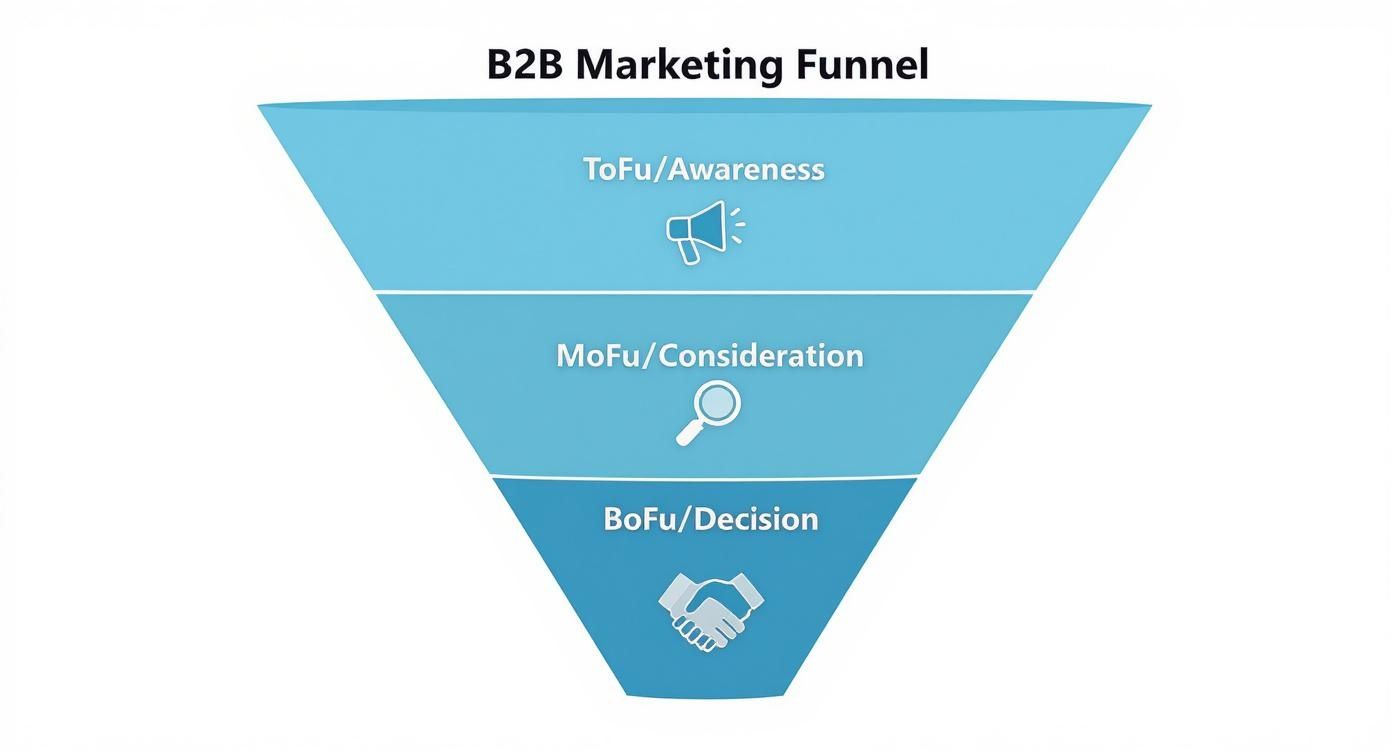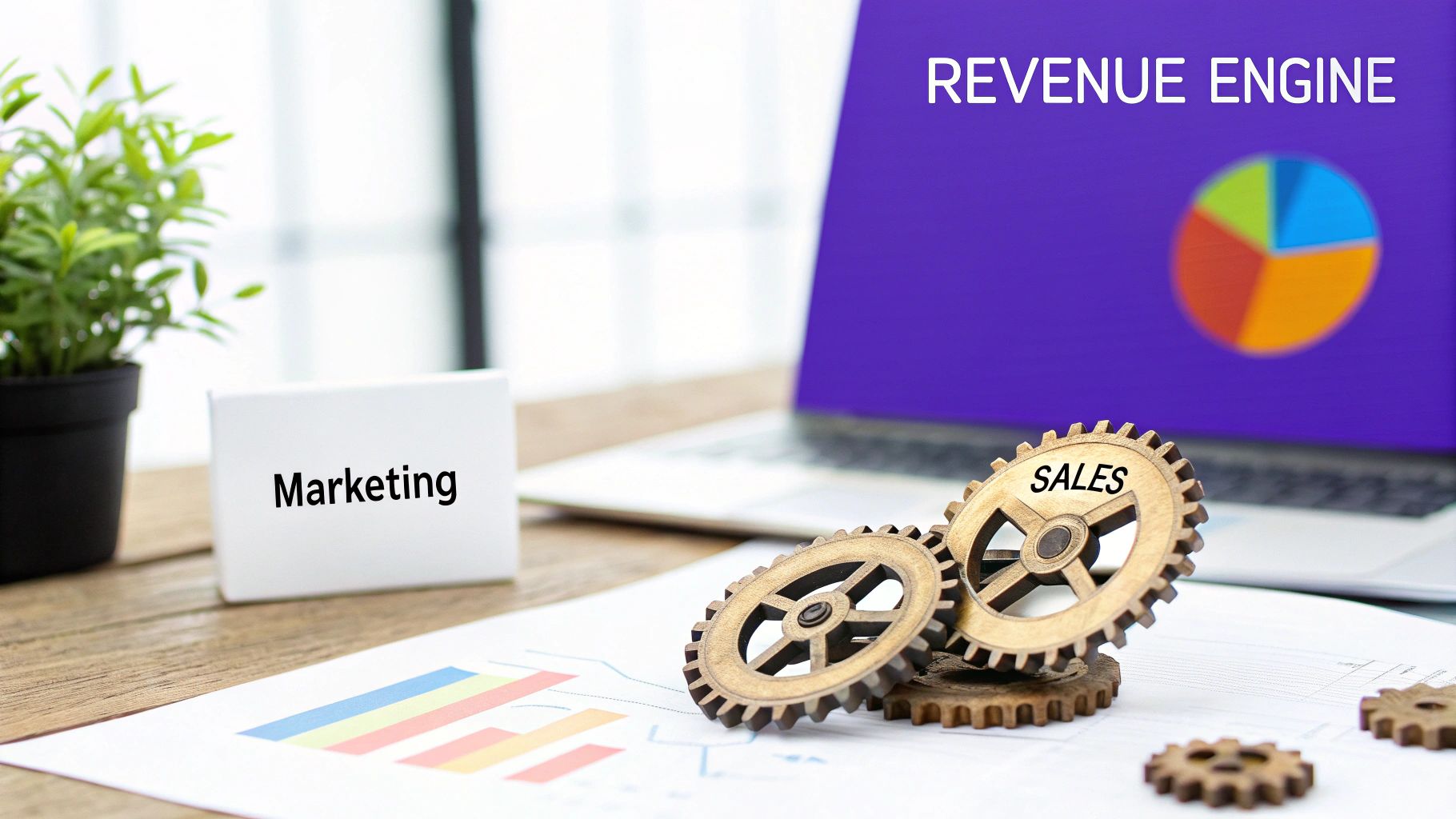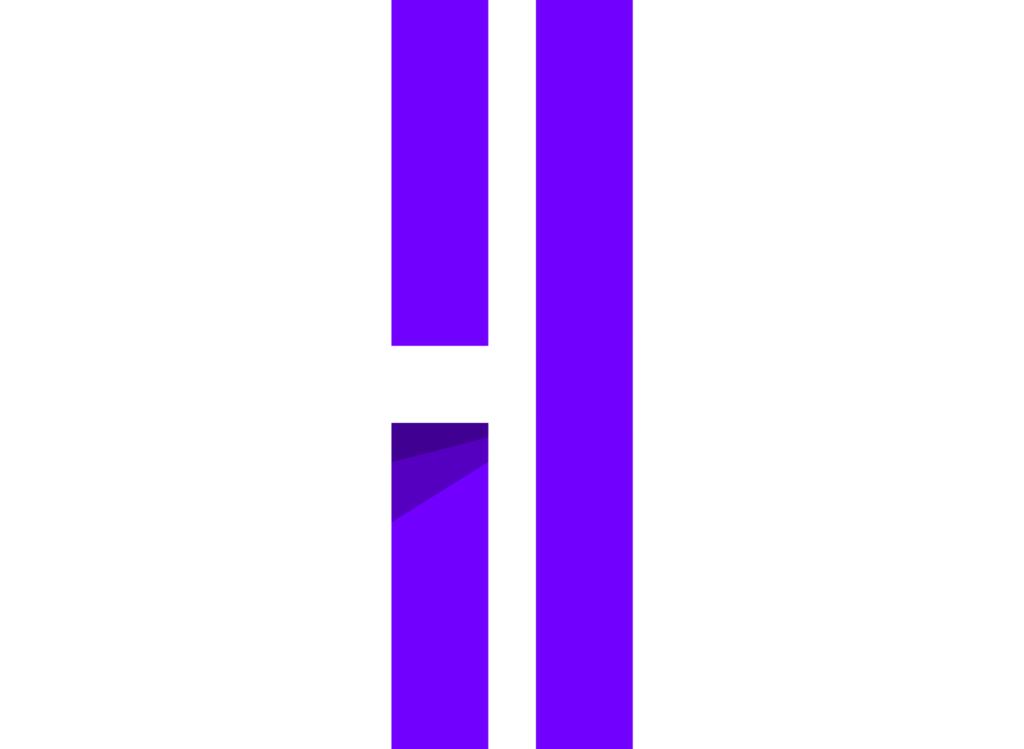It’s easy to get tangled up in marketing jargon, but the difference between demand generation and lead generation is actually pretty straightforward. Demand generation is all about creating awareness and desire for your solution, often long before a buyer even knows they have a problem. On the other hand, lead generation is about capturing the contact information of people who are already interested.
Think of it this way: demand gen creates the appetite, while lead gen serves the meal. A recent Forrester study found that companies with aligned demand and lead generation strategies achieve 15% to 20% higher revenue growth.
Understanding the Core Difference in B2B Marketing

Too many B2B marketers use "demand generation" and "lead generation" interchangeably. In reality, they're two distinct philosophies with different goals, tactics, and metrics. Confusing them leads to wasted ad spend and a leaky sales funnel.
Demand generation is the long game. It’s a strategy focused on educating your market and building brand authority. The goal is to become the go-to resource in your industry, so when a need finally arises, your company is the first one that comes to mind. This is typically done through high-value, ungated content that builds trust over time. You can dive deeper in our guide on what is demand generation.
Lead generation, conversely, is much more tactical and immediate. Its main job is to convert existing interest—often created by those demand generation efforts—into actionable contacts for your sales team. This means gated content, clear calls-to-action, and a direct exchange of information.
Demand Generation vs Lead Generation At a Glance
To put it all into perspective, this table breaks down the fundamental differences between these two critical marketing functions. It’s a high-level look to keep things clear.
| Attribute | Demand Generation | Lead Generation |
|---|---|---|
| Primary Goal | Create awareness and educate the market | Capture contact information from interested prospects |
| Audience Focus | A broad audience that may not know they need you | A targeted audience already showing buying intent |
| Core Content | Ungated educational content (blogs, podcasts, videos) | Gated offers (webinars, ebooks, demos) |
| Main Metrics | Website traffic, content engagement, brand mentions | Conversion rates, cost per lead (CPL), MQLs |
| Funnel Stage | Top of the Funnel (ToFu) | Middle of the Funnel (MoFu) |
In the Canadian market, this strategic distinction is already paying off. Recent data shows that 68% of Canadian B2B marketers attribute higher-quality leads to their demand generation initiatives. What’s more, 59% of marketers reported that inbound strategies, fuelled by demand generation, are their best source of leads.
Understanding this foundational difference is the first step toward building a revenue engine that actually works. Ready to build a strategy that integrates both for maximum impact? Contact us to explore how we can help.
Mapping Strategies Across the B2B Marketing Funnel
To really see the difference between demand generation and lead generation, it helps to map each one to the B2B marketing funnel. The best way to think about them isn’t as competing ideas, but as sequential stages in a cohesive journey that guides a prospect from being a complete stranger to a happy customer. Each strategy has a specific job to do.
Demand generation is the undisputed champion of the Top of the Funnel (ToFu). At this early stage, potential customers might not even know they have a problem, or they're just starting to poke around for information. The last thing they want is a sales pitch; what they're looking for is education and insight. Your goal here isn't to snag an email address—it's to build brand awareness and establish your company as a trusted authority. You're creating the first spark.
For example, a Toronto-based cybersecurity firm could create an in-depth blog post series on "Emerging Data Privacy Threats for Canadian Retailers." The content is purely educational, doesn't ask for anything in return, and positions the firm as a helpful expert long before anyone thinks about buying.
Dominating the Top of the Funnel with Demand Generation
Your ToFu strategy is all about giving away value freely to build an audience. High-impact demand generation tactics are designed to attract and engage prospects who aren't in a buying cycle yet.
- Insightful Blog Posts: Regularly publishing SEO-optimized content that addresses your audience's core challenges.
- Original Research Reports: Conducting industry surveys and sharing the findings to generate buzz and backlinks.
- Engaging Podcasts and Videos: Creating accessible, shareable media that educates your market on relevant topics.
A fantastic example of this is the Canadian tech success story, Shopify. Their blog and free business tools are masterful demand generation engines. By providing immense value on topics like e-commerce and entrepreneurship, they built a massive, loyal audience that naturally turns to their platform when ready to launch an online store. Their content strategy has helped them attract millions of merchants worldwide.
Activating the Middle of the Funnel with Lead Generation
Once prospects move from awareness into the consideration phase, they enter the Middle of the Funnel (MoFu). They now get the problem and are actively looking at potential solutions. This is precisely when lead generation takes the stage. The trust you built with your ToFu content now gives you permission to ask for their contact information in exchange for something even more valuable.
This handoff is critical. Research shows that nurtured leads make 47% larger purchases than non-nurtured leads. By capturing their details, you can start a more direct, personalized conversation to guide them closer to a decision.
Now, that same cybersecurity firm could offer a gated webinar titled "A 5-Step Framework to Secure Your Customer Data." Prospects who got value from the initial blog posts are now far more likely to register, officially becoming a lead. This content is more specific and solution-oriented, designed to convert the interest you originally sparked.
Key lead generation tactics for the MoFu stage include:
- Detailed Whitepapers and eBooks: Offering comprehensive guides that require an email submission to download.
- Expert-Led Webinars: Hosting live events that promise deep dives into specific problems and their solutions.
- Interactive Tools and Demos: Providing ROI calculators, free trials, or product demos that showcase your solution's direct value.
By seamlessly mapping these strategies across the funnel, you create a powerful system. Demand generation fills the top of your funnel with an educated and engaged audience, which in turn makes your lead generation efforts more effective and cost-efficient.
Ready to build a marketing funnel that connects awareness directly to revenue? Contact us to discuss how we can map a winning strategy for your business.
Comparing Goals, Metrics, and Strategic Timelines
To really get the difference between demand generation and lead generation, you need to look at how they're built: their goals, how success is measured, and the timelines they operate on. While they both feed into revenue, they play on completely different fields. Confusing them is like using a marathon training plan for a 100-metre sprint—sure, both involve running, but the strategy and what counts as a win are worlds apart.
The main goal of demand generation is to build up brand equity and become a leader in your category. It’s all about creating an educated, engaged audience that views your company as the ultimate authority. Think of it as a long-term investment in your brand’s reputation and market presence, designed to make future sales feel easier and more natural.
On the other hand, lead generation has a much more direct and immediate objective: capturing qualified sales contacts. The goal here is purely transactional. It’s about converting existing interest into a clean list of names and emails for your sales team to follow up on. It focuses on capturing demand, not creating it from scratch.
Measuring Success Differently
Because the goals are so distinct, the way you measure success for each strategy has to be different too. Demand generation zeroes in on leading indicators—the early signs that your awareness and influence are on the rise.
Key metrics for demand generation include:
- Share of Voice (SOV): How visible is your brand in the market compared to your rivals?
- Website and Blog Traffic: Are you drawing more visitors to your educational content?
- Content Engagement: Are people sticking around? Are they sharing your stuff? You'll track things like time on page, social shares, and comments to see if your message is actually landing.
Lead generation, however, is all about the lagging indicators tied directly to sales pipeline and efficiency. Success is measured by tangible conversions and how cost-effective your campaigns are.
Metrics for lead generation often include:
- Cost Per Lead (CPL): The average cost to get one new contact through a specific campaign.
- Marketing Qualified Leads (MQLs): The total number of leads that hit your predefined qualification criteria.
- Conversion Rates: The percentage of visitors who fill out a form on a landing page or for a gated asset.
This infographic does a great job of showing where each strategy lives within the B2B marketing funnel.

As you can see, demand generation owns the top of the funnel (ToFu) by building that broad awareness. Lead generation then kicks in at the middle of the funnel (MoFu) to turn that interest into actual prospects.
Contrasting Strategic Timelines
The timeline is another huge differentiator. Demand generation is a strategic, long-term marathon. Building real brand authority doesn't happen with a flip of a switch; it takes consistent, dedicated effort over months, sometimes years. Success is cumulative, with momentum building slowly but surely.
For example, a B2B software company might launch a podcast. It could easily take 6-12 months of putting out consistently great episodes before they see a real uptick in organic traffic and brand recognition. But that long-term effort pays off by creating a sustainable engine for inbound interest.
Lead generation works on a much shorter, more tactical timeline. It’s made up of distinct campaigns—like a webinar or an eBook launch—that often run for just a few weeks or a month. You can measure the results almost immediately, which gives you quick feedback on how well the campaign performed.
According to Salesforce, companies that excel at lead nurturing generate 50% more sales-ready leads at a 33% lower cost. This really drives home how a solid foundation of demand generation makes those shorter-term lead generation campaigns so much more effective.
For those of us in the Canadian market, this distinction is especially important. While demand generation metrics like social engagement are great for building long-term brand visibility, lead generation metrics like CPL are critical for measuring the immediate effectiveness of our tactical plays. Companies that skip demand generation often find themselves running out of people to talk to, because they have no engine creating fresh interest at the top of the funnel.
To give you a better sense of these differences at a glance, we've broken down the key strategic elements in the table below.
Detailed Strategic Comparison Demand Gen vs Lead Gen
| Criterion | Demand Generation | Lead Generation |
|---|---|---|
| Primary Goal | Build brand awareness, create desire, and establish authority. It's about educating the market and becoming the go-to expert. | Capture contact information from interested prospects. The goal is to convert existing demand into a list of qualified leads for sales. |
| Key Metrics | Share of Voice (SOV), organic website traffic, content engagement (time on page, shares), brand mentions, inbound link growth. | Cost Per Lead (CPL), Marketing Qualified Leads (MQLs), conversion rates (landing pages, forms), lead quality scores, pipeline contribution. |
| Typical Timeline | Long-term and ongoing. Results are cumulative and often take 6-18 months to show significant, measurable impact on revenue. | Short-term and campaign-based. Results are measured in weeks or months, providing immediate feedback on tactical performance. |
This table highlights the core strategic differences, helping you decide where to focus your resources based on your immediate and long-term business goals.
Ultimately, while a metric like CPL is important, it’s just one piece of a much larger puzzle. A great CPL is meaningless if you have to spend an enormous amount to actually acquire that customer in the end. You can learn more about this by reading our guide on how to calculate customer acquisition cost.
Proven Tactics and Channels for B2B Success

Understanding the theory behind demand gen versus lead gen is one thing; putting it into practice is another challenge entirely. Making the leap from concept to execution demands a clear playbook—one that maps high-impact tactics to the right goals. For B2B companies, it all comes down to knowing when to educate freely and when to ask for a prospect's details.
A successful program hinges on deploying the right tactics at the right time. With demand generation, the focus is on creating genuine value and building an audience without asking for anything in return. For lead generation, the strategy pivots to converting that earned interest into measurable sales opportunities.
High-Impact Demand Generation Tactics
The core goal of demand generation is to become a trusted voice in your industry. You achieve this by consistently delivering expertise and value, making your brand the first one prospects think of when a need arises. To maximize reach and build goodwill, this content is always ungated.
Common demand generation tactics include:
- Ungated Thought Leadership: This covers insightful blog posts, articles, and original research that tackle your audience's biggest pain points. The key is to provide genuine solutions and fresh perspectives, cementing your brand as an authority.
- Industry-Specific Podcasts: A podcast lets you host nuanced conversations and feature industry experts, building a loyal following over time. It creates an intimate connection with your audience that's tough to replicate with other formats.
- Engaged LinkedIn Communities: Building and nurturing a community on platforms like LinkedIn allows you to foster direct conversations, share valuable content, and position your team as approachable experts.
Success Story: A Canadian Fintech's Triumph
A prime example of demand generation in action comes from a Canadian fintech startup. By consistently publishing high-quality, ungated guides on complex financial regulations, they became the go-to resource for small businesses in their niche. This content-first approach tripled their organic website traffic in just over a year and built a powerful brand presence that competitors struggled to match, ultimately contributing to a 250% increase in qualified inbound inquiries.
Proven Lead Generation Methods
Once you've built awareness and trust through demand generation, it's time to capture that interest with targeted lead gen tactics. These methods offer higher-value, specialized content in exchange for contact information, signalling a prospect's readiness to move down the funnel. You can explore a variety of effective B2B lead generation strategies in our detailed guide.
Effective lead generation tactics include:
- Expert-Led Webinars: Hosting a webinar on a specific, solution-oriented topic is a powerful way to attract engaged prospects. The registration form acts as the gate, converting attendees into qualified leads for your sales team.
- Gated Research Reports: While you might share high-level findings publicly for demand generation, the full, in-depth report is a valuable gated asset. Prospects who download it are showing strong interest in both the data and your analysis.
- Hyper-Targeted PPC Campaigns: Running pay-per-click ads that point to a dedicated landing page with a clear offer—like a free demo or consultation—is a classic lead gen tactic. It targets users with high buying intent who are actively searching for solutions.
The data for Canadian companies strongly supports a content-centric approach. For instance, Canadian companies with active blogs generate 13 times more leads than those without one. Furthermore, content marketing delivers three times the leads at a 62% lower cost compared to traditional outbound methods, with organic search and social media emerging as dominant lead sources.
By thoughtfully selecting from this playbook, B2B marketers can build a balanced program that excels at both creating and capturing demand. Contact us to find the right tactical mix for your business.
Building a Unified and Cohesive Revenue Engine

The sharpest B2B companies have moved past the old "demand gen vs. lead gen" debate. They’ve figured out that pitting these functions against each other creates internal friction and stalls growth. The real goal isn't to pick a winner; it's to build a single, integrated system where both work together to power a predictable revenue engine.
This unified approach dismantles the ‘vs’ mindset completely. It positions demand generation as the essential groundwork that makes lead generation more efficient and profitable. When you invest in educating your market and building brand authority first, you're warming up your audience long before you ever ask for their email.
So, when you finally present a gated offer, you're not talking to strangers. They already know who you are, trust your expertise, and see the value you bring. That makes them far more likely to convert.
Creating Synergy Between Demand and Lead Generation
Achieving this synergy takes more than just running both types of campaigns; it demands a deliberate operational shift. Your teams need to be strategically aligned and measured against shared business outcomes, not separate marketing metrics. The focus has to move from departmental KPIs to a collective responsibility for revenue growth.
This integrated model hinges on a few core principles:
- Shared Revenue Goals: Both teams must be measured on their contribution to the pipeline and closed-won deals, not just MQLs or website traffic.
- Integrated Reporting: A single dashboard should track the entire customer journey, from the first touchpoint with a demand gen asset to the final conversion through a lead gen form.
- Continuous Feedback Loops: Sales insights on lead quality must be fed back to the demand gen team. This helps them refine content and targeting to attract the right audience from the start.
A crucial statistic shows why this is so vital: companies that excel at lead nurturing—a process that bridges demand and lead generation—generate 50% more sales-ready leads at a 33% lower cost. It’s a clear financial argument for building a cohesive system.
A Canadian Success Story in Practice
To see this principle in action, look at a fast-growing Canadian SaaS company. Initially, their marketing budget was skewed heavily toward bottom-of-funnel lead gen, like paid search for demo requests. They got leads, sure, but their customer acquisition cost (CAC) was through the roof, and the sales cycle was painfully long.
Recognizing the problem, they made a strategic pivot. A significant chunk of their budget was reallocated to top-of-funnel demand creation. They launched an ungated resource hub filled with expert guides and started a weekly podcast tackling their industry's biggest challenges.
The results were transformative. Over 18 months, their organic traffic soared, and their brand became synonymous with thought leadership in their niche. As a result, their lead generation campaigns became dramatically more effective. Prospects filling out demo forms were already educated and sold on their expertise. This strategic shift allowed them to cut their customer acquisition cost by a staggering 40% while shortening their sales cycle.
Their success wasn't about choosing demand gen over lead gen. It was about using demand generation to create fertile ground for their lead generation efforts to flourish. By building a unified engine, they created a sustainable and unstoppable growth model.
Are you ready to stop the internal debate and build a truly cohesive revenue engine? Contact us today to learn how our strategic guidance can align your marketing efforts for maximum impact.
Strategic Advice for Canadian B2B Companies
Navigating the demand generation versus lead generation landscape isn't about picking a side; it's about tailoring your strategy to your company's stage of growth. For Canadian B2B companies, especially those in the startup and scale-up phases, every dollar counts. Making smart choices early on sets the foundation for sustainable, long-term success.
For early-stage startups with lean budgets, the pressure to deliver leads now is immense. But jumping straight into lead generation without a base of brand awareness is a costly mistake. The most effective approach is to first build an authoritative voice in a specific niche with organic, low-cost demand generation.
Guidance for Startups
If you're a startup, your limited resources should go toward building a rock-solid brand foundation. This means becoming the go-to expert in a well-defined area.
- Niche Content Creation: Focus on high-value, ungated content like blog posts and guides. Solve very specific problems for your ideal customer to build trust and attract an audience organically.
- Community Building: Get active in relevant LinkedIn groups and online forums. Your goal isn't to sell; it's to help, answer questions, and build a reputation for genuine expertise.
This initial focus on demand generation makes your future lead generation efforts far more efficient. A recent study highlights that companies focusing on nurturing—a key part of this process—generate 50% more sales-ready leads at a 33% lower cost. When you educate your audience first, you create a warm market that’s much more receptive when you're finally ready to make an offer.
Strategy for Scale-Ups
For established scale-ups, the challenge shifts from initial awareness to balanced, predictable growth. You have the resources to run a more sophisticated, dual-pronged marketing program. The key is to create a portfolio that blends long-term brand building with short-term pipeline needs.
A smart allocation would see the majority of your resources—say, 60-70%—invested in long-term demand creation. This includes thought leadership, original research, and brand campaigns. The remaining 30-40% can be dedicated to targeted lead generation campaigns designed to capture existing demand and fuel immediate sales conversations.
One of the most effective ways to manage this complexity is by engaging a Fractional CMO. This model provides executive-level marketing leadership and strategic expertise without the overhead of a full-time C-suite hire. A Fractional CMO can build the framework that integrates both demand and lead generation, ensuring your growth is both strategic and sustainable.
By tailoring your approach to your company’s stage, you can build a powerful marketing engine that’s perfectly suited for the unique Canadian B2B landscape.
Ready to build a strategy that drives real revenue growth? Contact us today to explore how our expertise can help.
A Few Final Questions
Navigating the nuances of demand gen vs. lead gen often sparks a few practical questions for Canadian B2B marketers. Let's tackle some of the most common ones to help clarify your path forward.
Can a Business Succeed with Only Lead Generation?
It's tempting to try, but it's a short-term play that rarely pays off in the long run. Without demand generation warming up your market, lead gen efforts often come with punishingly high costs and diminishing returns.
Think of it this way: relying only on capturing existing interest means you'll eventually run out of people who are already looking for you. A SaaS client of ours learned this the hard way before shifting their budget; once they started creating demand before trying to capture it, they cut their customer acquisition costs by a staggering 40%.
How Should a Small Business Allocate Its Marketing Budget?
If you’re a startup or small business with a lean budget, your best bet is to start with low-cost, high-impact demand generation. This is where you prioritize organic efforts that punch above their weight.
Focus on creating niche blog content that solves a real problem, building a genuine community on LinkedIn, or even starting a podcast. These initiatives build brand authority and an engaged audience over time. Once you have consistent inbound traffic, you can strategically layer in targeted lead gen campaigns, like a gated webinar, knowing your investment will land with an already-warm audience. Contact us and we can help you build the right budget.
What Is Sales' Role in a Demand Generation Strategy?
Sales is absolutely critical—they're your eyes and ears on the ground. Your sales team is on the front lines, talking directly with customers and prospects every single day. This gives them an unfiltered feed of the most urgent pain points, challenges, and questions your audience has.
By creating a solid feedback loop, marketing can tap into these insights to shape demand generation content that actually resonates and addresses real-world problems. This alignment ensures that marketing attracts the right audience from the get-go, making the entire sales process smoother and far more effective. A study by MarketingProfs shows that tightly aligned sales and marketing teams achieve 36% higher customer retention rates.
Ready to build a strategy that blends demand creation and lead capture for unstoppable growth? The team at B2Better has over 45 years of combined B2B marketing experience to guide you. Contact us today to learn how our Fractional CMO services can build your revenue engine.
- Written by: B2Better
- Posted on: November 16, 2025
- Tags: b2b marketing strategy, canadian b2b, Demand generation, demand generation vs lead generation, Lead generation

